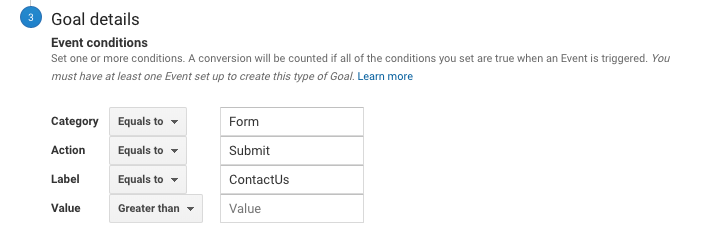Discover the Limitations of Google Analytics Goals: Revealing the Data Kind That Remain Untrackable
As services significantly rely on data-driven decision-making, recognizing the limitations of tools like Google Analytics ends up being paramount. While Google Analytics Goals deal beneficial insights into individual interactions, there exist data types that elude tracking, presenting challenges to a comprehensive understanding of individual actions.
Insufficient Customer Journey Tracking
Incomplete user journey monitoring within Google Analytics can hinder the capability to properly examine individual actions. When the individual trip is not completely tracked, there are gaps in the data that avoid an extensive understanding of how individuals communicate with a web site. This lack of insight can bring about missed out on possibilities for optimization and enhancements to the user experience.
One common issue with insufficient customer trip monitoring is the failure to see the full path that individuals take previously finishing an objective or leaving the website. Without this details, it is challenging to identify where customers might be running into barriers or friction factors that avoid them from converting. In addition, insufficient tracking can cover the impact of certain marketing initiatives or site modifications on customer actions.
To address this restriction, it is vital to establish proper tracking devices within Google Analytics to catch the entire user trip. This may entail establishing occasion tracking, goal funnels, or utilizing devices like Google Tag Manager to ensure that no vital interactions go unrecorded. By acquiring a comprehensive sight of the user journey, internet site owners can make even more educated choices to improve customer engagement and drive conversions.
Acknowledgment Challenges
Navigating through attribution difficulties in Google Analytics requires a thorough understanding of how different touchpoints contribute to the overall conversion process. Attribution difficulties arise from the intricacy of contemporary client journeys, where individuals interact with multiple networks prior to transforming.
One typical attribution challenge is the difficulty in associating conversions to the appropriate resource, particularly in cases where customers communicate with multiple networks prior to transforming. Additionally, cross-device tracking poses an additional acknowledgment challenge, as customers usually switch over between tools during their journey, making it testing to track their communications flawlessly.
Offline Conversions
Provided the obstacles connected with connecting conversions accurately in online channels, the dimension of offline conversions presents a substantial opportunity for marketing professionals looking for an extra thorough understanding of their clients' trip. Offline conversions refer to actions that consumers take in the physical globe, such as making acquisitions in brick-and-mortar shops or over the phone, going to occasions, or involving with published materials - what data is google analytics goals unable to track. These conversions are important for organizations that run both online and offline, as they provide beneficial understandings into the effectiveness of advertising projects throughout various touchpoints
Tracking offline conversions typically positioned a considerable difficulty for marketing professionals, as it was testing find more information to connect these actions back to details online interactions accurately. With advancements in technology, such as the integration of CRM systems, unique identifiers, and promo code codes, companies can currently link the void in between online and offline information to get an extra all natural sight of client behavior. By effectively determining offline conversions, marketers can maximize their approaches, allocate resources extra effectively, and inevitably enhance the general customer experience.
Cross-Device Tracking
Cross-device monitoring plays a crucial function in recognizing the interconnected nature of consumers' digital interactions throughout numerous tools. In today's omnichannel world, where customers effortlessly change between desktop computers, smartphones, and tablet computers, tracking their habits across these gadgets is vital for marketers to gain an extensive view of their customer trip.

In addition, personal privacy concerns and policies such as GDPR and CCPA have additionally difficult cross-device monitoring. With customers requiring more control over their data and increased limitations on tracking modern technologies, marketing professionals must find privacy-compliant and ingenious methods to link individual communications throughout tools.
Dynamic Web Content Engagement
Comprehending customer involvement with vibrant web content is pivotal in optimizing electronic marketing techniques for improved audience communication. Dynamic material describes web site aspects that change based on user actions, choices, or various other factors, offering a tailored experience. Tracking individual interactions with vibrant material positions obstacles for conventional analytics tools like Google Analytics.
While Google Analytics can track standard communications like clicks and page views, it might have a hard time to capture more nuanced involvements within dynamic content. what data is google analytics goals unable to track. Metrics such as time invested in certain dynamic components, hover activities, or communications within pop-ups are typically not easily quantifiable making use of common tracking techniques. This limitation prevents online marketers' capacity to totally grasp just how users are engaging with dynamic content and customize their techniques as necessary

Conclusion
In verdict, Google Analytics objectives have constraints in tracking incomplete individual trips, connecting conversions accurately, capturing offline conversions, tracking cross-device interactions, and determining vibrant web content involvement. These constraints highlight the value of discovering additional monitoring techniques and devices to acquire a more detailed understanding of individual habits and conversions beyond what Google Analytics can offer.
While Google Analytics Goals offer useful insights into customer communications, there exist information kinds that avoid tracking, presenting difficulties to a detailed understanding of individual behavior.Incomplete user trip monitoring within Google Analytics can impede the capacity to precisely examine individual behavior. When the customer trip is not fully tracked, there are gaps in the information that stop a detailed understanding of exactly how customers interact with a site.One typical issue with insufficient individual journey monitoring is the failure to see the complete path that users take before finishing an objective or leaving the website. By obtaining a comprehensive sight of the user trip, site owners can make more informed choices to improve user involvement and drive conversions.